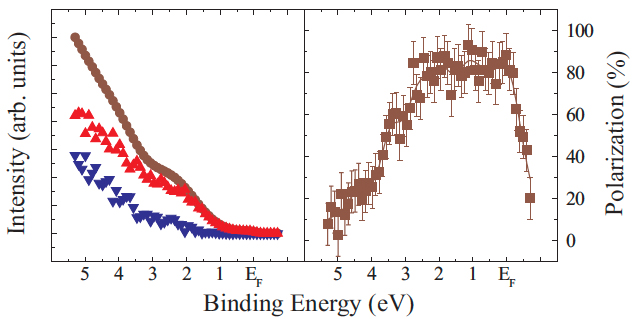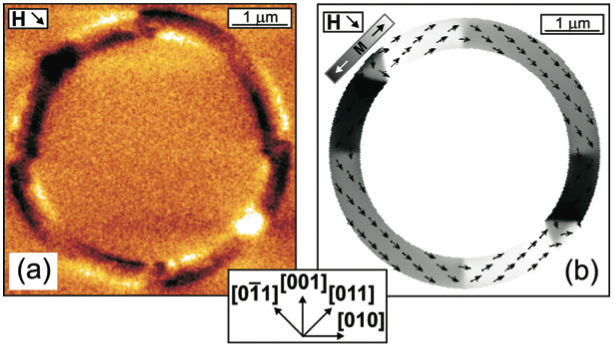Ferromagnetic oxides
Half-metallic ferromagnetic oxides
The intriguing feature of half-metallic ferromagnetic oxides is metallic conductivity for one spin component and insulating behavior for the other one. The theoretically predicted 100% spin polarization at the Fermi level (EF) makes them promising materials for magnetoelectronic devices. Theoretical calculations made on the basis of the local spin-density approximation (LSDA) to the density-functional theory have predicted only minority spin states at EF for Fe3O4 [1,2] and only majority spin at EF for CrO2 [3,4].
1. A. Yanase and K. Siratori, J. Phys. Soc. Jap. 53, 312 (1984).
2. Z. Zhang and S. Satpathy, Phys. Rev. B 44, 13319 (1991).
3. K.-H. Schwarz, J. Phys. F: Met. Phys. 16, L211 (1986).
4. S. P. Lewis, P. B. Allen, and T. Sasaki, Phys. Rev. B 55, 10253 (1997).
Spin-resolved band structure of Fe3O4 and CrO2
Spin-polarized photoemission spectroscopy (SP-PES) represents a powerful tool to study the band structure of solids with spin-resolution. We study the electronic structure of thin epitaxial films of magnetite (Fe3O4) and chromium dioxide (CrO2) by means of spin- and angle-resolved photoemission spectroscopy. The Fe3O4(111) epitaxial films show a maximum spin polarization value of −(80 ± 5)% near EF at 293 K. The SP-PES study of CrO2 (100) films yields a spin polarization of approximately +90% at EF at 293 K (see Figure at the bottom). This value and the magnitude of the gap in the minority states are in good agreement with the prediction of the half-metallic nature of CrO2.

Microstructures
Nanoscale ferromagnetic elements play a key role in the emerging field of spintronics, which takes advantage of the electron spin for the realization of future high-speed, high-density, and nonvolatile devices. The performance of such devices can be enhanced using ferromagnetic materials exhibiting a high degree of spin polarization. In this context magnetite and chromium dioxide are very important materials combining relatively high Curie temperature with a high spin polarization. We focus on the investigation of magnetization configurations by means of verious experimental techniques as well as their correlation to the geometry in epitaxial micron-sized elements (see Figure at the bootom).

Magnetic oxide nanoparticles
Magnetic nanoparticles are currently used in ferrofluids, e.g. as magnetic seals and inks, in magnetic tapes as storage media, and for magnetic resonance imaging in biomedical applications. Future applications may well include high-density, bit-patterned magnetic recording media or therapeutic agents for cancer treatment. Among the magnetic moment of the particles further microscopic characteristics include the magnetic exchange interactions and anisotropies, which may or may not lead to an ordered spin structure. These microscopic quantities define an energy barrier, which has to be overcome during magnetization reversal, either when applying an external magnetic field to trigger switching or by thermal fluctuations. Hence, the energy barrier defines the blocking temperature, above which the particles become superparamagnetic, as well as the coercive field and the energy dissipation during hysteresis.
Our research is focused on the synthesis and investigation of magnetic oxide nanoparticles with new and well-defined morphologies in order to understand the correlation between morphology and magnetic properties.
